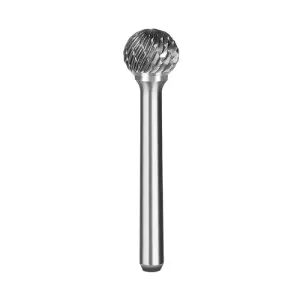Hardness and Cutting Efficiency
One of the primary advantages of Carbide Rotary Burs over high-speed steel (HSS) files is their good hardness. Tungsten carbide, the material from which these burs are made, ranks significantly higher on the Rockwell hardness scale than HSS. This means it maintains a sharper cutting edge for a longer period, allowing for faster material removal and greater precision. This is particularly beneficial in industries requiring high-tolerance finishing, such as aerospace, mold-making, and automotive component production. Compared to HSS files, Carbide Rotary Burs excel in working with hardened steel, stainless steel, cast iron, and even non-metal materials like ceramics and composites.

Extended Tool Life and Cost Efficiency
While Carbide Rotary Burs may come with a higher initial price tag than high-speed steel alternatives, they offer a much longer tool life. Their resistance to wear and heat buildup during high-speed rotation means they need to be replaced far less frequently. This reduces downtime and tool change frequency in industrial settings, which translates to lower operational costs over time. In contrast, HSS tools tend to dull more quickly, especially when used on harder materials or in high-volume production scenarios.
Enhanced Heat Resistance for Demanding Applications
Another key benefit of Carbide Rotary Burs is their good heat resistance. During aggressive cutting or grinding, tools generate significant friction and heat. HSS files are prone to softening at elevated temperatures, causing performance degradation and reduced accuracy. Carbide Rotary Burs, on the other hand, maintain their structural integrity even under extreme thermal conditions. This makes them ideal for continuous use in high-speed rotary tools, CNC machines, and pneumatic grinders without requiring frequent cool-down intervals.
Precision and Surface Quality in Finishing Work
They are manufactured with extreme precision, allowing for more consistent surface finishes and detailed work. Their availability in a wide range of shapes—cylindrical, ball, flame, tree, cone, and others—makes them highly adaptable to complex geometries. This versatility enables technicians and machinists to achieve smoother finishes and more accurate contours, particularly in mold deburring, porting, and tool and die work. In contrast, HSS files are more limited in shape options and often leave a rougher finish that requires secondary processing.
Greater Versatility Across Materials
The application scope of it far exceeds that of high-speed steel files. They are compatible with a broader range of materials, including hardened steels, titanium alloys, nickel-based superalloys, and non-metals like bone, plastic, and fiberglass. This cross-material versatility means workshops can rely on a single Carbide Rotary Burs set for multiple tasks, improving workflow efficiency. HSS files, while suitable for softer metals and light-duty work, struggle when used on harder or abrasive materials.
Conclusion
In modern manufacturing and fabrication environments, precision, speed, and reliability are paramount. Carbide Rotary Burs significantly outperform high-speed steel files in these areas, offering longer life, better cutting performance, and good versatility. From tool longevity to enhanced surface finishes and adaptability to various materials, the advantages of Carbide Rotary Burs are clear. For professionals aiming to reduce tooling costs, improve output quality, and streamline operations, they are the optimal solution in today’s high-demand machining landscape.